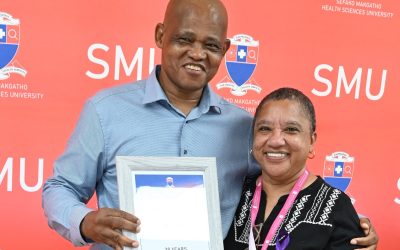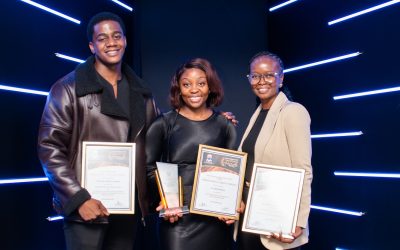Scholars from the Departments of Chemistry at Sefako Makgatho Health Sciences University (SMU) joined leading researchers from across South Africa at the 10th Collaboration Symposium, hosted by the Centre for Rubber Science & Technology and the Department of Chemistry at Nelson Mandela University (NMU). Held on 11–12 September at NMU’s Ocean Sciences Campus, the symposium marked a significant milestone, showcasing innovative solutions to some of Africa’s most pressing scientific and societal challenges.
 For two days, scholars, industry experts, and emerging scientists converged to tackle Africa’s most pressing research challenges. The symposium’s message was clear: collaboration is not an option; it is a necessity. Over the past decade, the event has grown into one of the continent’s premier platforms for multidisciplinary research, fostering networks that span institutions and disciplines.
For two days, scholars, industry experts, and emerging scientists converged to tackle Africa’s most pressing research challenges. The symposium’s message was clear: collaboration is not an option; it is a necessity. Over the past decade, the event has grown into one of the continent’s premier platforms for multidisciplinary research, fostering networks that span institutions and disciplines.
SMU’s presence was particularly strong. Scholars from the Department of Chemistry made significant contributions to the programme, underscoring the university’s growing reputation for innovative, cross-disciplinary science. Senior Professor and Head of the Material Science Niche Area at SMU, Tshwafo Motaung, highlighted the benefits and purpose of collaboration. In essence, the symposium was established to shine a spotlight on African scholars, particularly the designated group, in alignment with the vision of the National Development Plan. Dr Dan Molefe (SMU Chemistry staff) expanded the symposium’s focus on applied sciences of flame-retardant materials. A standout moment came from Mmabatho Matlaila (SMU Chemistry MSc), whose presentation on green nanotechnology using banana peels drew widespread attention. “We need to look at our local resources differently,” she explained. “Banana peels are often discarded as waste, yet they hold the potential to contribute to sustainable innovation.” Her work demonstrated how African ingenuity can turn everyday materials into global solutions.
The line-up of speakers reflected the depth of African scholarship. Dr Lungelwa Mahanjana of NMU explored the cross-disciplinary impact of natural products in her talk titled “Beyond Molecules.” Professor Linda Linganiso of UNISA highlighted how adding value to waste can drive a circular economy, while Dr Nobathembu Faleni of Walter Sisulu University showcased how invasive Lantana camara plants could be turned into useful products. Emerging voices also made their mark, with Mr Zwivhuya Munyai of NMU presenting on flame-resistant conveyor belts made from recycled tyres, and Dr Jane Nkhebeyane emphasised the need to engage solution-driven projects.
 The energy among students and early-career researchers was particularly inspiring. Prof Motaung observed, “These young scholars are not just talking about problems, they are already designing the solutions Africa needs, and that gives hope that one day Africa will set its research agenda.”
The energy among students and early-career researchers was particularly inspiring. Prof Motaung observed, “These young scholars are not just talking about problems, they are already designing the solutions Africa needs, and that gives hope that one day Africa will set its research agenda.”
While the enthusiasm was palpable, participants acknowledged that the real challenge lies ahead. As Prof Lehlohonolo Koao (University of the Free State) put it, “The proof is in the pudding. We must ensure these collaborations go beyond conferences and result in tangible outcomes.”
Motaung expressed confidence that the partnerships forged at the Ocean Sciences Campus would outlive the event, fuelling projects that address Africa’s most urgent needs: sustainable energy, environmental stewardship, and industrial innovation.
This symposium was not just about sharing research; it was about shaping the continent’s future. By building networks across universities and disciplines, SMU is positioning itself as a catalyst for solutions grounded in African contexts. A decade in, the Collaboration Symposium has become more than a conference; it is a launchpad for action. And if the energy of 2025 is any indication, the next decade promises breakthroughs that will redefine how Africa innovates for itself and the world.
By Tumelo Moila



